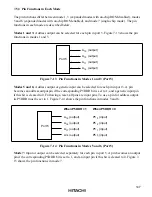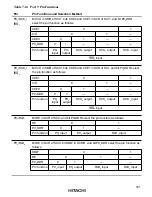
160
Port 9 Data Direction Register (P9DDR): P9DDR is an 8-bit write-only register that can select
input or output for each pin in port 9.
Bit
Initial value
Read/Write
7
—
1
—
6
—
1
—
5
P9 DDR
0
W
5
4
P9 DDR
0
W
4
3
P9 DDR
0
W
3
2
P9 DDR
0
W
2
1
P9 DDR
0
W
1
0
P9 DDR
0
W
0
Reserved bits
Port 9 data direction 5 to 0
These bits select input or
output for port 9 pins
A pin in port 9 becomes an output pin if the corresponding P9DDR bit is set to 1, and an input pin
if this bit is cleared to 0.
P9DDR is a write-only register. Its value cannot be read. All bits return 1 when read.
P9DDR is initialized to H'C0 by a reset and in hardware standby mode. In software standby mode
it retains its previous setting. If a P9DDR bit is set to 1, the corresponding pin maintains its output
state in software standby mode.
Port 9 Data Register (P9DR): P9DR is an 8-bit readable/writable register that stores output data
for pins P9
5
to P9
0
.
Bit
Initial value
Read/Write
7
—
1
—
6
—
1
—
5
P9
0
R/W
4
P9
0
R/W
4
3
P9
0
R/W
3
2
P9
0
R/W
2
1
P9
0
R/W
1
0
P9
0
R/W
0
Reserved bits
Port 9 data 5 to 0
These bits store data
for port 9 pins
5
When a bit in P9DDR is set to 1, if port 9 is read the value of the corresponding P9DR bit is
returned. When a bit in P9DDR is cleared to 0, if port 9 is read the corresponding pin level is read.
Bits 7 and 6 are reserved. They cannot be modified and are always read as 1.
P9DR is initialized to H'C0 by a reset and in hardware standby mode. In software standby mode it
retains its previous setting.
7.9.3 Pin Functions
The port 9 pins are also used for SCI input and output (TxD, RxD, SCK), and for
IRQ
5
and
IRQ
4
input. Table 7-14 describes the selection of pin functions.















































